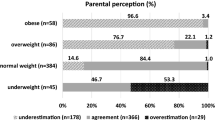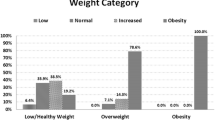Abstract
Objective
The aim of this study was to identify characteristic lifestyles in children with obese parents.
Methods
8,030 children (4,072 males and 3,958 females) aged 6 to 7 years were investigated. A questionnaire relating to the lifestyles of children was distributed through elementary schools for completion by parents. The heights and weights of parents were self-reported. A parent with a body mass index (weight in kilograms divided by the square of height in meters) greater than the 90th percentile for gender (26.7 kg/m2 for fathers and 24.3 kg/m2 for mothers) was defined as an obese parent. A chi-square test for each trend was applied to evaluate an increasing trend in the frequency or level of each lifestyle in children with obese parents.
Results
Children with obese parents were significantly associated with increasing trends in the proportions categorized by irregular intake of breakfast, faster eating, longer TV watching, and shorter sleeping hours.
Conclusions
These lifestyles are considered to be possible risk factors for the development of obesity. These characteristic lifestyles observed in children with obese parents could strengthen the relationship between child and parental body compositions, in addition to the genetic predisposition to obesity in children with obese parents. These findings indicate that education with lifestyle modification for obese parents will be required to prevent further weight gain in children with obese parents.
Similar content being viewed by others
References
Anderson RE, Crespo CJ, Bartlett SJ, Cheskin LJ, Pratt M. Relationship of physical and television watching with body weight and level of fatness among children: Results from the Third National Health and Nutritional Examination Survey. JAMA 1998; 279: 938–942.
Murata M. Children and lifestyle-related diseases. [in Japanese] Journal of Japan Medical Association. 1998; 119: 917–946.
Whitaker RC, Wright JA, Pepe MS, Seidel KD, Dietz WH. Predicting obesity in young adulthood from childhood and parental obesity. N. Engl. J. Med. 1997; 337: 869–873.
Maffeis C, Talamini G, Tato L. Influence of diet, physical activity and parents' obesity on children's adiposity: a four-year longitudinal study. Int. J. Obes. 1998; 22: 758–764.
Alison DB, Kaprio J, Korkeila M, Koskenvuo, Neale MC, Hayakawa K. The heritability of body mass index among an international sample of monozygotic twins reared apart. Int. J. Obes. 1996; 20(6): 501–506.
Fogelholm M, Nuutinen O, Pasanen M, Myohanen E, Saatela T. Parent-child relationship of physical activity pattern and obesity. Int. J. Obes. 1999; 23(12): 1262–1268.
Francis CC, Bope AA, MaWhinney S, Czajka-Narins D, Alford BB. Body composition, dietary intake, and energy expenditure in nonobese, prepubertal children of obese and nonobese biological mothers. J. Am. Diet. Assoc. 1999; 99(1): 58–65.
Nguyen VT, Larson DE, Johnson RK, Goran MI, Fat intake and adiposity in children of lean and obese parents. Am. J. Clin. Nutr. 1996; 63(4): 507–513.
Kagamimori S, Yamagami T, Sokejima S, et al. The relationship between lifestyle, social characteristics and obesity in 3-year-old Japanese children. Child. Care. Health. Dev. 1999; 25: 235–247.
Takahashi E, Yoshida K, Sugimori H, Miyakawa M, Izuno T, yamagami T, Kagamimori S. Influence factors on the development of obesity in 3-year-old children based on the Toyama study. Prev. Med. 1999; 28: 293–296.
Numata N, Yamagami T, Sokejima S, Kagamimori S. Changes in body mass index and the influencing factors on the development of obesity in school children. [in Japanese] Journal of Japan Association of Cerebro-Cardiovascular Control 2000; 35: 35–43.
Kirkwood B. Essentials of Medical Statistics. Blackwell Science Ltd 1988: 102–104.
Klesges RC, Shelton ML, Klesges LM. Effect of television on metabolic rate: potential implication for childhood obesity. Pediatrics 1993; 91: 281–286.
Spiegel K, Leproult R, Cauter EV. Impact of sleep debt on metabolic and endocrine function. Lancet 1999; 354: 1435–1439.
Reaven GH, Lithell H, Landsberg L. Hypertension and associated metabolic abnormalities: the role of insulin resistance and the sympathoadrenal system. N. Engl. J. Med. 1996; 334: 374–381.
Sheen AJ, Byrne MM, Plat L, Leproult R, Cauter EV. Relationship between sleep quality and glucose regulation in normal humans. Am. J. Physiol. 1996; 271: E261-E270.
Boyle PJ, Avogaro A, Smith L, et al. Role of GH in regulating nocturnal rate of lipolysis and plasma mevalonate levels in normal and diabetic humans. Am. J. Physiol. 1992; 263: E168-E172.
Bolton-Smith C, Woodward M, TunstallPedoe H, Morrison C. Accuracy of the estimated prevalence of obesity from self reported height and weight in an adult Scottish population. J. Epidemiol. Community Health 2000; 54: 143–148.
Nieto-Garcia FJ, Bush TL, Keyl PM. Body mass definitions of obesity: sensitivity and specificity using self-reported weight and height. Epidemiology 1990; 1: 146.
Hill A, Robert J. Body mass index: a comparison between self-reported and measured height and weight. J. Public. Health Med. 1998; 20(2): 206–210.
Twisk JW, Kemper HC, van Mechelen W, Post GB, van Lenthe FJ. Body fatness: longitudinal relationship of body mass index and the sum of skinfolds with other risk factors for coronary heart disease. Int. J. Obes. 1998; 22(9): 915–922.
Bandini LG, Schoeller DA, Cyr HN, Diets WH. Validity of reported energy intake in obese and nonobese adolescents. Am. J. Clin. Nutr. 1990; 52(3): 421–425.
Author information
Authors and Affiliations
Corresponding author
Rights and permissions
About this article
Cite this article
Sekine, M., Yamagami, T., Saito, T. et al. Characteristic lifestyles in 6-year-old children with obese parents: Results of the toyama birth cohort study. Environ Health Prev Med 6, 104–108 (2001). https://doi.org/10.1007/BF02897954
Received:
Accepted:
Issue Date:
DOI: https://doi.org/10.1007/BF02897954




